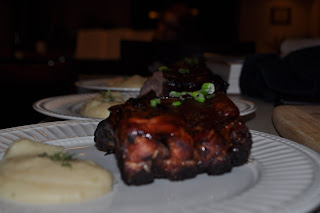Own Recipe; the bible on cream soups is
The Professional Chef at 404.
Ingredients
3 oz. butter
4 oz. flour
1 gal. stock (see notes below on stock choices)
4 lbs. peeled, cubed butternut squash
1 lb. chopped standard
mirepoix
6 cl. garlic
4 T curry powder
2 t white pepper
2 t cayenne
12 oz cream
Makes one gallon.
Cream soups are challenging in a couple of ways, but way more approachable than they might first seem. The Professional Chef, cited above, offers great guidelines for how to build your own recipes for this type of soup. The following steps and commentary should allow you to confront some of the common problems I encountered while working on the recipes I now use.
The formulas in the Professional Chef (and thus this recipe) are fully scalable, although I've found that cutting the formula smaller than a third can offer dicey results.
1) Heat the butter and flour in a large pot to make blond roux.
Roux is flour cooked in fat, which is used in a variety of basic sauces (including a few of the
French Mother Sauces) as a thickening agent. The classic formula for roux calls for 2 parts fat for every 3 parts flour (measured by weight). When the fat first starts to absorb the flour, the mixture should have the consistency of wet sand. I find myself frequently adding fat to reach this texture, but there's no harm in starting from the basic formula.
Roux is described by color: white, blonde, nut or chocolate, brick, black. These colors form as the fat cooks the flour. As the flour is cooked, it loses thickening capacity, but gains a bread-like flavor that becomes very earthy and nutty. Therefore, the longer you plan to cook the roux, the greater volume you need to use to achieve the same thickening effect.
Bubbling roux moving from white to blond
The bread flavor can be pronounced and pleasant in some applications (gumbo often uses brick or black roux), but I think most cream soups benefit from lighter preparations which help highlight the main ingredients and spices.
2) Add the stock in a thin stream, stirring constantly. Bring to boil, then reduce to simmer.
There are a few important points here.
a) Choice of stock: For the purpose of this particular soup, store bought chicken stock works well. I have used homemade duck, lamb and turkey stocks with great success. Making a batch of stock at home is easy;
learning to make stock, especially degreasing and filtering properly, is a pain in the ass.
When using the formula to make your own recipe, consider what stock will match your main ingredient. Some cream soup recipes call for milk instead of stock. I have yet to try a recipe with milk that I like, but there is surely one out there.
b) Slow addition, constant stirring: Adding the stock so that the roux doesn't clump is the first real challenge of cream soups. In my experience, if you can get your veloute (a French mother sauce of stock thickened with roux) to turn out smooth, you're halfway to a great cream soup.
I add the first cup of stock a tablespoon at a time, stirring the roux until the stock is completely incorporated before adding the next. At that point I add the remaining stock very slowly. Patience is key; if you add the stock extremely slowly you can skip a lot of my learning curve.
c) Stock before mirepoix: Some recipes, including specific recipes in
The Professional Chef, call for "sweating" or frying the mirepoix in the fat before adding flour. By this method, the roux forms around the aromatic ingredients. I suck at this all the time. Adding the mirepoix before the stock makes cooking the roux evenly and incorporating the first tablespoons of stock harder. If you fail here, the soup will have flour chunks. If you choose that method, proceed with caution.
3) Add mirepoix, garlic and squash. Cook until vegetables are tender. (About 1 hour).
4) Blend soup until smooth.
This is the second challenge of cream soups.
Immersion blenders make this job a snap (with a little practice). In most kitchens, you have to use a stand blender and work in batches, storing the pureed soup in a separate bowl or saucepan. If you go this route, be sure not to overload the blending jar or jam in the highest setting suddenly; you'll get hot soup all over your hands. Work in small batches and pulse the liquid a few times before holding down the button.
Once the soup is pureed, you can stick it in the fridge for a day or two before serving. Simply cover the soup until you want to use it, reheat and continue the recipe. A sort of drier skin will develop on the resting soup, just stir that in as it heats, this layer will rehydrate with no effect on taste.
5) Add spices and cook for 15 minutes to slightly reduce.
6) Cut heat to low, add cream, stir and serve.
Use a spoon to ladle some extra cream on the soup, if you're gentle it will float and look impressive. A garnish of chopped cilantro or green onions will add a bit of freshness and color.
How did it turn out?
This is one of my most frequently requested dishes, and with good reason. It's earthy, satisfying and easy to present impressively. The batch in the photos is maybe the best I've ever made and I can guarantee that because I really took my time adding the stock to the roux. It may also be due to the homemade stock; in almost all cases store bought stocks are fine, but home-made adds an incredible depth of flavor.













